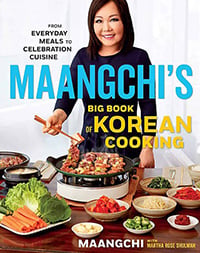When it starts to get colder like it is these days, I make bone broth for me and my family, every year.
Koreans consider bone broth to be very nutritious and rejuvenating, which is why I like to fortify my family’s bodies for the wintertime. We believe that it makes you strong, so we bring it to friends and relatives who are sick or have just gotten out of the hospital. The most important thing about making this broth is that it turns out milky-white and nutritious, with no impurities. So it’s important to soak the bones in cold water first.
You might want to save some time and use your slow cooker or your pressure cooker, but I tried this and it doesn’t work. The bones need to simmer to make a proper milky broth. Some of my longtime readers will remember I made bone broth for dishes like seolleontang and maybe you are wondering what is new in this recipe. This recipe is made with only bones, not beef, and it’s for a large portion.
I give the timing for this recipe, but we Koreans never watch the clock when making bone broth. Instead, we let our eyes be the judge and boil until the bones are spent: soft and spongy, with all the marrow boiled out. They should be smooth, with nothing on them at all. I turn off the stove at night time when I sleep, and then start it up again in the morning.
The resulting broth is rich, with a nutty aftertaste. You can serve it as a soup alongside rice, serve it as a drink, or use it as a broth when making other kinds of Korean soups, instead of water.
Ingredients
Makes 22 to 24 cups bone broth
- 6 pounds sliced beef leg bones and/or knuckle bones
Directions
Prepare bones
- Rinse the bones in cold water to remove blood and bone fragments. Place in a large bowl of cold water and soak for 8 hours or overnight. While soaking, change the water a couple of times.

- Drain the bones and put them into a large stock pot. I use my 10 quart stock pot. Add water until the bones are submerged.
Boil bones
- Cover and boil for about 20 minutes over high heat, until it is vigorously boiling. You will see lots of floating brownish stuff and fat.

- Remove from the heat. Drain the bones, rinse each bone with cold running water, scrub them (you can wear rubber gloves for this), and drain well.


- Wash the pot thoroughly and put the bones back to the clean pot.
- Fill the pot with water (I added 6½ quarts water to my 10 quarts pot). Cover and cook over high heat for about 30 minutes until the water starts boiling.

- Reduce the heat to low and simmer for 10 hours. Open the lid and stir the bones with a wooden spoon.

- Fill the pot with water, cover and simmer for 9 hours.

- Fill the pot with water again. Increase the heat to medium high heat and cook for 1 hour without the lid.

- Remove from the heat. Let it cool down a little bit until you can handle it.
Remove bones
- Remove all the bones from the broth and discard.
- Strain the broth over a large bowl. Discard the strained bits (or you can eat them). You will get about 22 to 24 cups of white milky bone broth.
- Let the broth cool to room temperature and refrigerate for several hours or overnight until the thick layer of the fat on the surface is solidified. Remove and discard the solid fat.

- You can put it into freezer safe containers and freeze up to 3 months.

Serve
- Ladle some hot broth into a bowl and serve with rice, chopped green onion, ground black pepper, kimchi, and other side dishes. When you eat it, add some chopped green onion, ground black pepper, and salt according to your taste, then add some rice and mix it together and eat.







































This looks great, Maangchi. So, your guk section seems to be mostly more elaborate soups. When I lived in Korea, we had guk with most meals, but they were very simple. Maybe a light broth with some seaweed or bean sprouts. Or a cloudy broth with some green onions. Sometimes there was some very small bits of meat or fish, but often not. I was wondering if you could do a series on “Daily guk” that can accompany a more complete meal. Most of the guks here could almost be a main dish.
I am a beef producer in South Hero, VT and would love to try your very best recipe with beef and Asian noodles, so that I can share it with my customers. Could you point me in the right direction?
Your enthusiastic presentation has moved me to poetry!!!
Korean Bone Broth
boil and wash
wash and boil
skim the froth
white the broth
food for the soul
Sagol-gukmul
This “poem” is a mess without consistent rhyme or meter. Hope you find it amusing.
There are lots of food bloggers like this but the best food blog “Beef bone broth” is yours. Much thanks for giving me a smart blog.